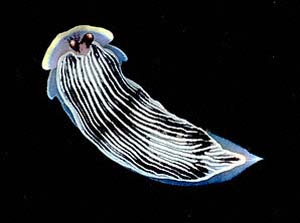
Armina cygnea
(Bergh, 1876)
Order: NUDIBRANCHIA
Suborder: ARMININA
Family: Arminidae
DISTRIBUTION
Known from all of Australia except Victoria and Tasmania.
PHOTO
Camp Cove, Sydney Harbour, New South Wales, 9m, October 1977. (45mm long).
Photo: Bill Rudman.
One of a number of species with a colour pattern of black and white longitudinal lines. See also Armina sp. 1. and Armina sp. 2.
See messages below from Leanne Atkinson on egg-laying and Janalie Besoff on feeding.
Reference:
• Bergh, L.S.R. (1876). Neue Beiträge zur Kenntniss der Pleurophyllidien. Malakoz. Blätt. 23: 1-14, pl. 1
Rudman, W.B., 1998 (March 9) Armina cygnea (Bergh, 1876). [In] Sea Slug Forum. Australian Museum, Sydney. Available from http://www.seaslugforum.net/find/armicyg
Related messages
Armina
February 16, 1999
From: Meenie
I hope you aren't too scientific to enjoy a little humor, but I have been using the name "Armina" as my computer name for several years now. I plugged it into a search engine to see what would come up and discovered a page full of pictures of me (armina cygnea) !!!
Thanks,
Meanie
Seattle,
Washington, USA.
http://www.geocities.com/Wellesley/1941
armina@series2000.com
Meenie, M., 1999 (Feb 16) Armina. [Message in] Sea Slug Forum. Australian Museum, Sydney. Available from http://www.seaslugforum.net/find/571Dear Meenie,
Glad to have brightened your day.
One obvious question I have - Why did you call your computer self "Armina"?
Bill Rudman.
Egg masses; Armina laying in sand
March 15, 1998
From: Leanne Atkinson
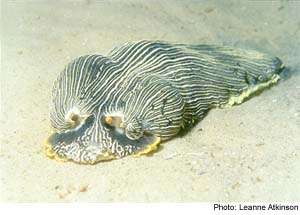
Here is some more photos of Armina cygnea which I took of the Little Beach, Port Stephens population. (19-24 January 1998, 9m). One picture shows the whole animal, head on, crawling across the sand. The others show them laying their very characteristic jelly-like egg mass which is anchored in the sand. As the pictures show they sit buried in the sand with only their head end exposed and swivel around as the egg mass is laid.
Leanne Atkinson.
atkin@hunterlink.net.au
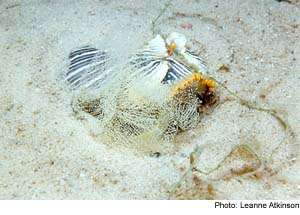
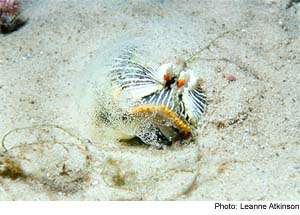
Thanks for the excellent shots of Armina laying its egg mass. With these photos and Greg Convery's of it feeding, we now know much more about Armina cygnea than we did two weeks ago. Most nudibranchs lay their eggs on a hard surface and stick the egg ribbon down as it is being laid. Those that lay their egg mass on a soft bottom need to either find a piece of rock or shell buried beneath the surface to attach their egg mass to, or like Armina, anchor it in the sand with a long mucus string. Each white speck is an individual egg...Bill Rudman
Rudman, W.B., 1998 (Mar 15). Comment on Egg masses; Armina laying in sand by Leanne Atkinson. [Message in] Sea Slug Forum. Australian Museum, Sydney. Available from http://www.seaslugforum.net/find/2Feeding habits of Armina cygnea
March 9, 1998
From: Janalie Besoff
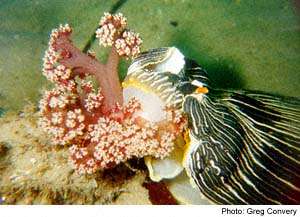
Dear Bill,
The following feeding observations were made at the southern corner of Little Beach, Port Stephens, New South Wales, at a depth of around 10 metres. The substrate is a mixture of sand and silt with occasional cobbles, mooring bases and sunken debris. It is subject to (strong) tidal currents which only stop for a few minutes at high and low tide.... Other divers also reported seeing Armina cygnea appearing from the sand and crawling all over nearby soft coral trees to feed.
Although individual arminids have been observed in the soft coral beds around Fly Point, there appears to have been a large group which travelled together over a restricted region of Little Beach, approximately parallel to the shoreline. They were most often sighted in low light conditions before dusk. One was found partly buried beside a sea pen, but most emerged from the sediment at some distance from any food source. (There are several sea-pens in the area but they are not as abundant as the soft-corals.) The only food divers saw them eating were the "cauliflower-like" purple soft corals. At times several arminids were seen clinging to and feeding on the same soft-coral "tree".
18 January 1997, between 5:10 and 6:20 pm, depth 15m: Arminids emerged from the substrate in an area devoid of macroscopic plants and attached animals. Some crawled slowly, headfirst; some tailfirst. An occasional animal flicked its body out of the sand and was washed around by the current before stabilising itself and crawling along the bottom. Most individuals moved in straight lines toward the nearby group of cauliflower soft corals. A mucus trail was left behind each one on the sand.
When an arminid reached a full grown soft coral tree it crawled up the "trunk" and along a branch to a groups of polyps. It then extended its mouth, to envelop a cluster of polyps and remained still while biting off the polyps. A trail of mucus covers the damaged area and remains for some time after the attack.
15 February 1997, between 4:25pm and 5:45pm-with photographer Greg Convery: On this occasion I attempted to speed up the photographing by placing an arminid near a soft-coral tree, but as its oral veil touched the soft-coral it recoiled and remained stationary near the base of the soft-coral colony. A loose branch of polyps washed past in the current so I touched it to the oral veil of another arminid which also recoiled as if stung. Perhaps the mucus they produce protects them form being stung while ingesting the soft-coral polyps.
The photo is one of a series in which arminids consumed two small soft-coral colonies. The animals engulfed the branches of polyps as noted before and eventually left only the "trunk" of each 10cm coral tree.
On both dives the arminids were also laying eggs. In some places long loops of eggs resembling nets were attached to the substrate at one point and left to wash in the current. The loops of eggs were not like the intricate rosettes laid by smaller nudibranchs and were about twice the length of the parent animal. Other partly buried arminids were laying egg masses. Fish (Pygmy leatherjackets and a small squire) also harrassed the arminids by tugging at their egg masses and in two cases, biting the right lateral portion of the oral veil. The arminids flinched but took no other aversive action..
Similar sightings occurred until the end of March. Other divers reported seeing individuals there from about September 1996. I hope these sightings are of some use and would suggest it might be interesting for a marine biologist to pursue the study in this area during January/ February in future years
Janalie Besoff.
Lambton, New South Wales.
This account of the feeding behaviour of Armina cygnea, near Fly Point, Port Stephens in New South Wales, was sent to me last year by Janalie Besoff, a keen diver. Because it was so interesting I arranged for it to be published in Shell News, the newsletter of the Malacological Society of Australasia. The report of a species of Armina feeding on a colony of the soft-coral Dendronephthya sp. is to my knowledge unique.
In Australian waters two genera of arminid nudibranchs have been found. One, Dermatobranchus, consists of a number of small species, usually less than 5mm long, which are often found feeding on soft-corals. I have found a number of species living and feeding on large colonies of Dendronephthya. The second genus, Armina, consists of much larger species, 30-100mm long, which burrow in sand and sandy mud, emerging at night to feed on sea-pens, a quite different order of octocorals. One species on the west coast of North America, Armina californica, puts on a spectacular light show when it is feeding, as the sea pen it feeds on (Renilla koellikeri) produces luminescent flashes every time it is bitten.
What Janalie's observations show, is that this species of Armina, probably Armina cygnea, is breaking the 'rules' by eating a soft-coral rather than a sea-pen. Observations such as this are a valuable way of building up information on the biology and natural history of our fauna. The reason we know so much about birds and mammals is because of the army of amateurs who are always out with binoculars watching and taking notes. Divers and intertidal collectors often observe incidents such as egg-laying and feeding which they quickly forget. If you see such incidents, take a photo (if you can), or make a note. You may have stumbled across something which will answer a long-standing question ... Bill Rudman.
Rudman, W.B., 1998 (Mar 9). Comment on Feeding habits of Armina cygnea by Janalie Besoff. [Message in] Sea Slug Forum. Australian Museum, Sydney. Available from http://www.seaslugforum.net/find/4